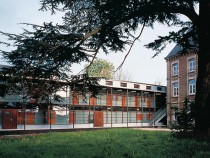
© Serge Demailly
The new development consists of a school and two related dwelling tracts, each accommodating 12 people. The buildings were incorporated into a historic ensemble, consisting of a 19th-century palace and a small 18th-century hunting lodge set in their own park-like grounds. The school was laid out at right angles to the palace, creating an open courtyard, in the middle of which stands a 200-year-old cedar. The new facade overlooking the courtyard is fully glazed, whereas the outer face consists of a series of brick elements and room-height windows. The brick panels, which take up the materials of the existing ensemble, are in the form of prefabricated, load-bearing, room-height monolithic slabs. This construction system is cheaper than traditional brickwork and also reduces the building period on site. Complementing these basic elements are a number of special connecting components, such as corner units, lintels and balustrades, all of which are co-ordinated to form a modular building system. The brick panels are 250–280 cm high, and their width is a multiple of 15 cm. This allows a flexible facade grid, within which openings can be freely positioned. The panels are available with or without core insulation and can be used as wall and roof elements. They are anchored to the foundations and other structural members with steel rods. The outer cavities in the panels serve as a means of air circulation to prevent condensation occurring on the insulation.



